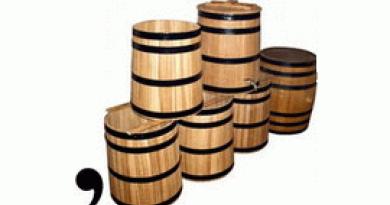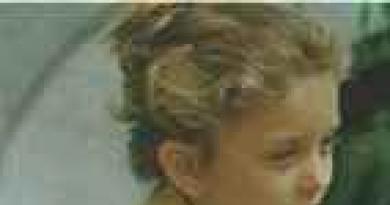Crafts on the theme “Take care of nature”, drawings on the theme “Ecology of nature” will help children instill a love for native land, learn to use waste material.
Contents of the article:
Children need to be taught a caring attitude towards nature from childhood. After all, if parents allow themselves to litter in the forest, then their children will behave the same way. If adults show children how to protect nature and love it, then the children will grow up to be worthy people. Spend more time in nature with your children, tell them about plants and trees. Collect natural materials: cones, bunches of rowan, plant seeds, so that you can then do joint work at home.
Crafts “Take care of nature”
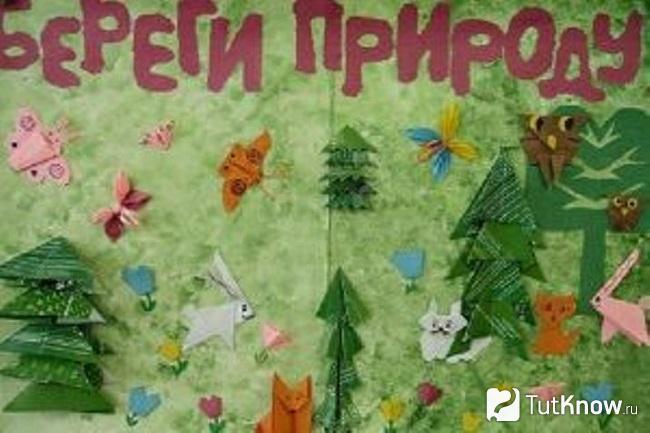
Children love to color. Therefore, print a poster on this topic in black and white and give the children freedom of creativity. Let them use crayons, pencils, markers or paints to add bright colors to the canvas. Tell them what color the elements of the poster should be, but if the children want to show their vision of the plot, do not interfere with them, let them show their individuality. Then teach them how to make crafts with the theme "Take care of nature." Prepare everything you need in advance.

Craft “Waterfall”
If you go on a picnic with your children, after the feast tell them that plant remains can be buried in the forest, they will rot. But this trick won’t work with plastic bottles. Therefore, you need to take them with you to throw them in the trash container or to do a wonderful job for which you need:
- plastic bottle;
- cardboard;
- scissors;
- water;
- cup;
- beads;
- colored paper;
- markers;
- gouache.
The blue cardboard sheet will turn into water. You need to glue beads at the bottom, and cut out something like pebbles from multi-colored paper.

All that remains is to glue the “fish” onto the blue cardboard and draw air bubbles in the water.
Crafts made from natural materials
To create it you will need:
- walnut;
- cone;
- dry grass;
- tree branches;
- sawed from a dry tree trunk, which will become a stand;
- glue.
With a bright marker along the edge of the stand, write “Take care of the forest!”, and if the child is already familiar with literacy, let him do it himself.

Drawings on the theme “Ecology of Nature”
Such creativity will also instill in children a love for their native land. If they were asked to bring drawings on the topic of environmental ecology to a children's institution, we can recommend the following.
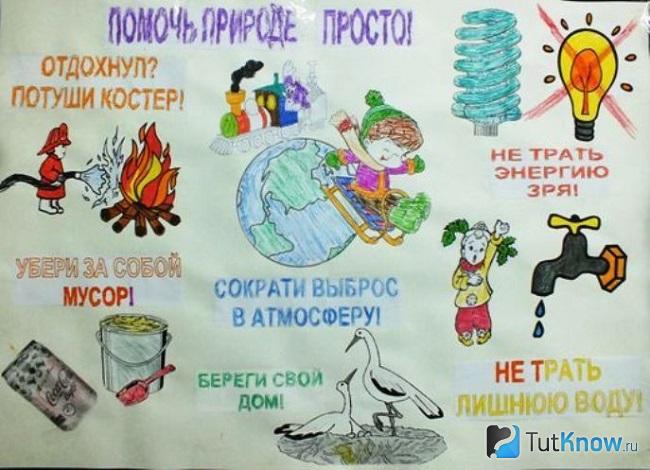
On this poster, the author shows how specifically each person can help preserve normal ecology and nature. To do this you need:
- pick up trash after yourself;
- After relaxing by the fire, be sure to put it out;
- don’t waste water;
- save energy;
- take care of your home.
Reducing harmful emissions into the atmosphere will also help preserve the environment. It is not for nothing that in the summer motorists are encouraged to switch to bicycles in order to get to work using this transport.
Parents can go on bike rides with their children, thus also engaging in outdoor sports.
The following drawing on the theme of natural ecology is symbolic. Under a bright rainbow, the child depicted a representative of animals, birds, insects, plants and calls on everyone to preserve our nature.
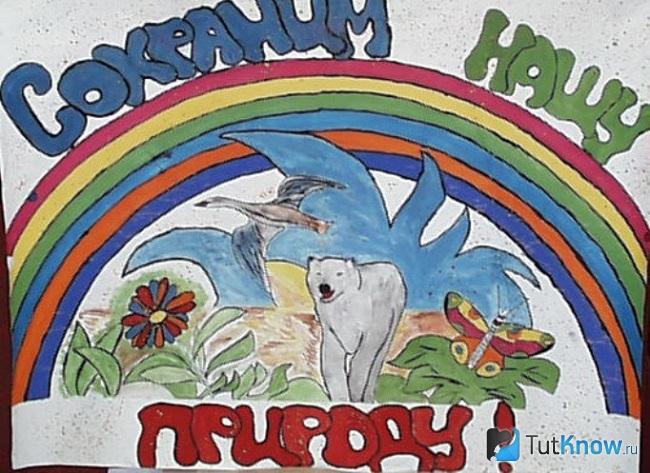
The following work is intended for schoolchildren. To make it, you will need:
- a sheet of paper or whatman paper;
- simple pencil;
- eraser;
- paints.
The picture is divided into 2 thematic parts. On the left is beautiful nature, a grazing horse, birds soaring in the blue sky, and on the right are industrial enterprises that produce harmful emissions into the atmosphere and, as a result, dead trees, bushes, and grass.
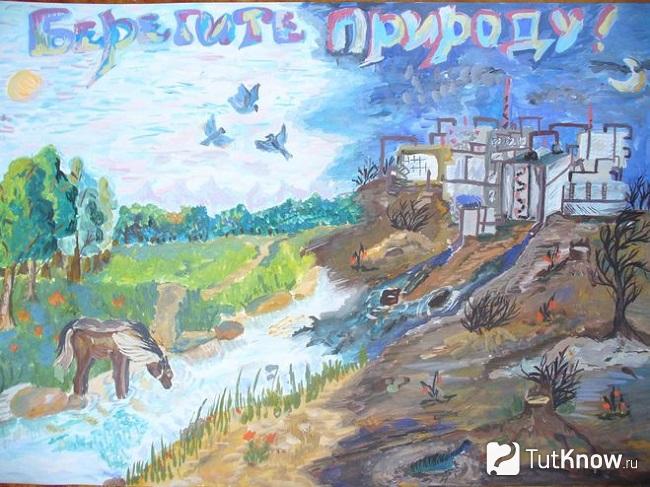
The following poster on the topic “Take care of nature” shows children that they need to protect the forest from fire.
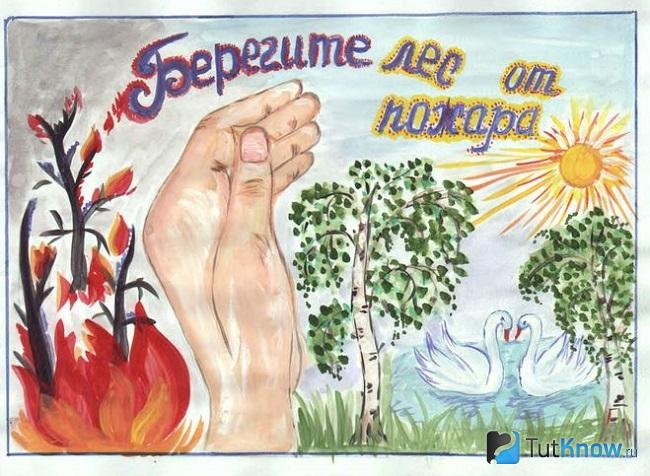
If your child is asked to draw a picture on such a topic, you can give him the following idea. There is a forest, a river, a rainbow, and animals.

If this drawing on the topic “Ecology of Nature” is intended for middle school students, the next one will be able to be reproduced by children from primary school and senior groups kindergarten. Show them how to draw tree canopies with conical fora and lush canopy. Children will also be able to draw lilies of the valley and strawberries.
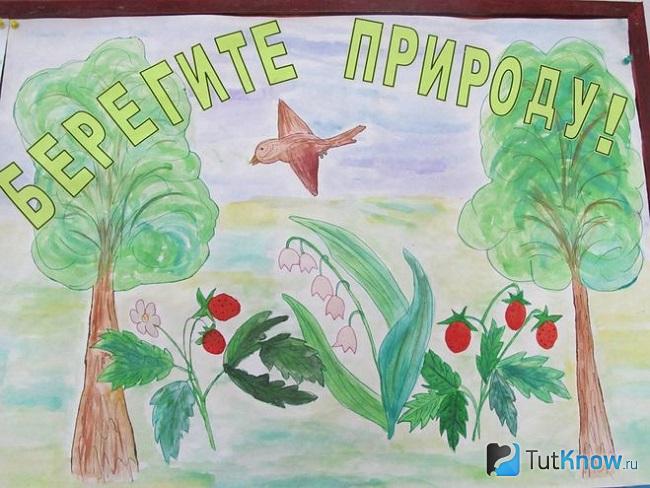
Another work was done using a very interesting technique. To make the same, take:
- a needle;
- colored threads;
- a sheet of white cardboard;
- simple pencil.
We start from the bottom of the canvas. Help your child thread the yellow thread through the eye of the needle and tie a knot at both ends of the thread. The rays of the sun can be made long or consisting of several stitches. Threads different colors children will embroider a rainbow and finish the work using the same technique.
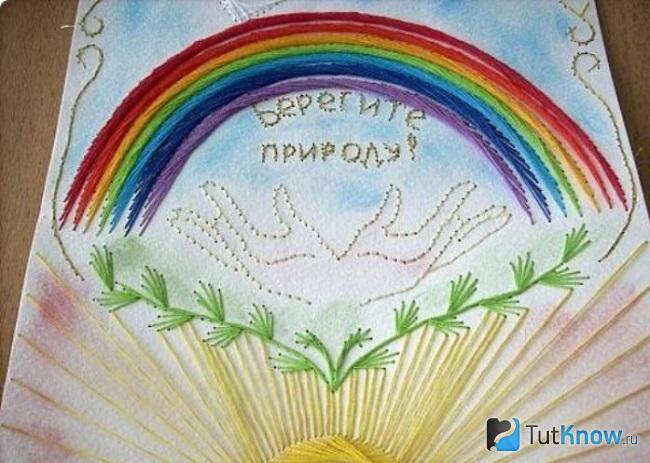
The following paintings are based on comparison and contrast.

On the right is a corner of the globe. Explain to the children that it will remain like this if we all protect nature. On the left you can see what it will be like if you litter and don’t take care to put out the fire behind you or burn it in in the wrong place. Pollution of water bodies will also lead to such sad consequences. A child will understand all this if he draws such a canvas.
Another work develops this idea and shows that people are able to resist air pollution; they need to reduce the amount of exhaust gases and pick up trash after themselves.
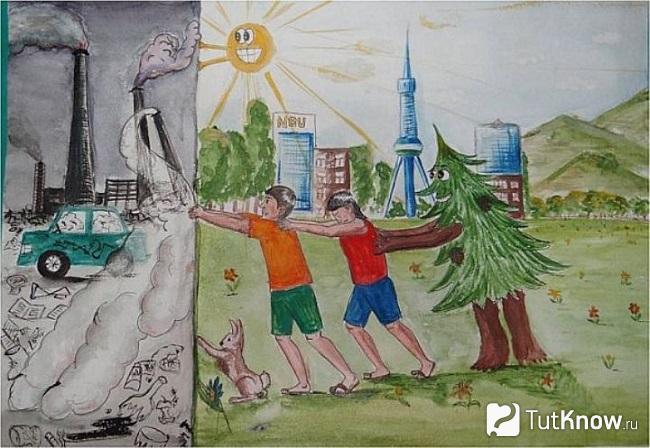
The following drawing is also intended to instill in children the right thoughts regarding the environment.
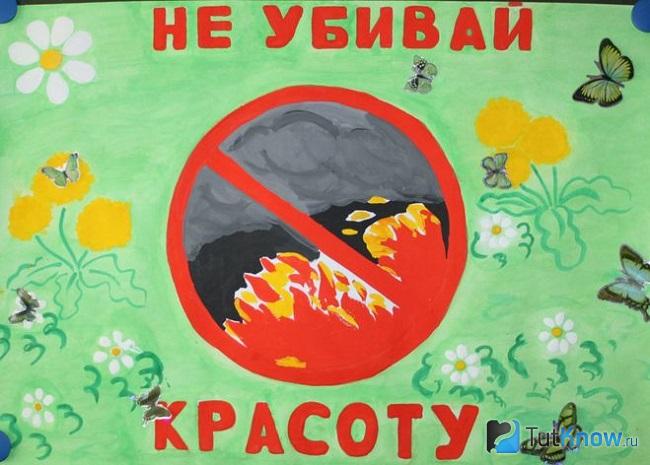
To let the kids know that you can make a lot of interesting things out of waste material, offer them the following ideas.
Crafts from garbage
Children love Kinder surprises, so they almost always have packaging for the gifts inside. Teach children by showing them what can be made from such waste material.
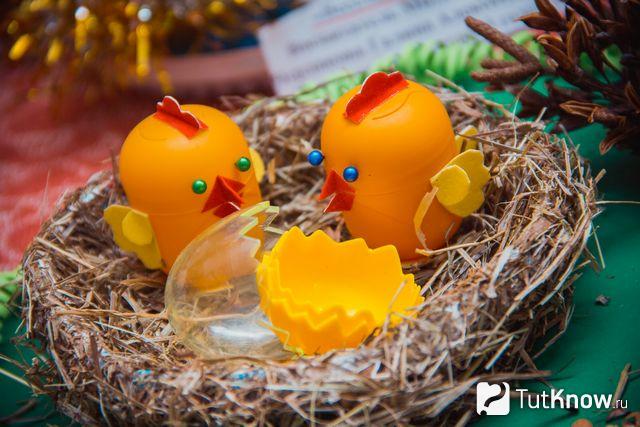
The result will be wonderful funny chickens. To make them, the kids will need:
- plastic containers for kinder eggs;
- glue;
- beads or pins;
- yellow and red cardboard;
- scissors.
You can pierce the top of the Kinder egg package with two pins. Then the remaining beads on the outside will become the chicken's eyes.
To make the shells, have parents cut the top of each package half in a zigzag pattern. This will be more difficult for children. Together with them, make a nest from straw or dry grass, or from thin twigs, fastening the elements with threads or glue.
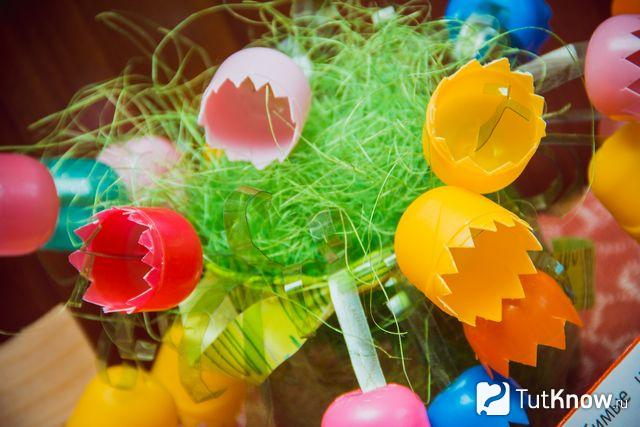
You can make such a picturesque bouquet out of garbage. To create it, take:
- Kinder egg packaging of different colors;
- scissors;
- sisal or green plastic bottles;
- cocktail straws;
- nail.
- Also cut the egg halves in a zigzag pattern. WITH reverse side use a heated nail to make a hole.
- Insert a straw into each, first push the edge further to cut it into 2 parts. Then tie them in a knot, then this “stem” will be firmly fixed in the flower.
- Arrange them all in the same way. Connect the flowers, cover with sisal, tie with ribbon.
- If there is no sisal, then you need to cut off the top and bottom of the green plastic bottle and cut the remaining part into a thin strip in a spiral.
- Kinder egg packaging;
- toothpicks;
- scissors;
- plasticine;
- paints;
- thin colored rope;
- flat lid from a cardboard box;
- green colored paper;
- glue.
- Let your child glue the lids of the box inside colored paper, this is a carpet of green grass. Toothpicks need to be pre-painted, when dry, stick along the edge of the box, like a picket fence. These pickets are tied with rope in several rows to form a fence.
- Pierce the bottom parts of the plastic blanks with an awl and have the child insert toothpick legs here. He will coat them with black plasticine, make small circles from it, and attach them to the cow’s body. Then you need to sculpt the horns, and the muzzle from yellow plasticine.
- In the same way, let the child create other animals: a pig, a cat, a dog, a sheep. Then you’ll get a whole village farm, and you already know how to make kinder chickens.
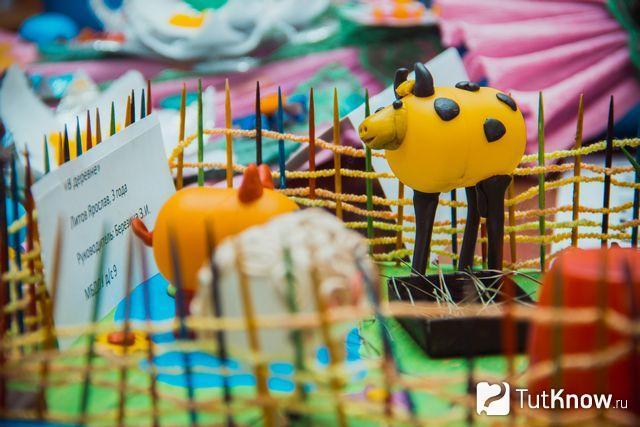
The following crafts, take care of nature, are no less interesting in execution. After all, after a feast or celebration, plastic cups and disposable plates remain. Make a clown out of them together with your children.
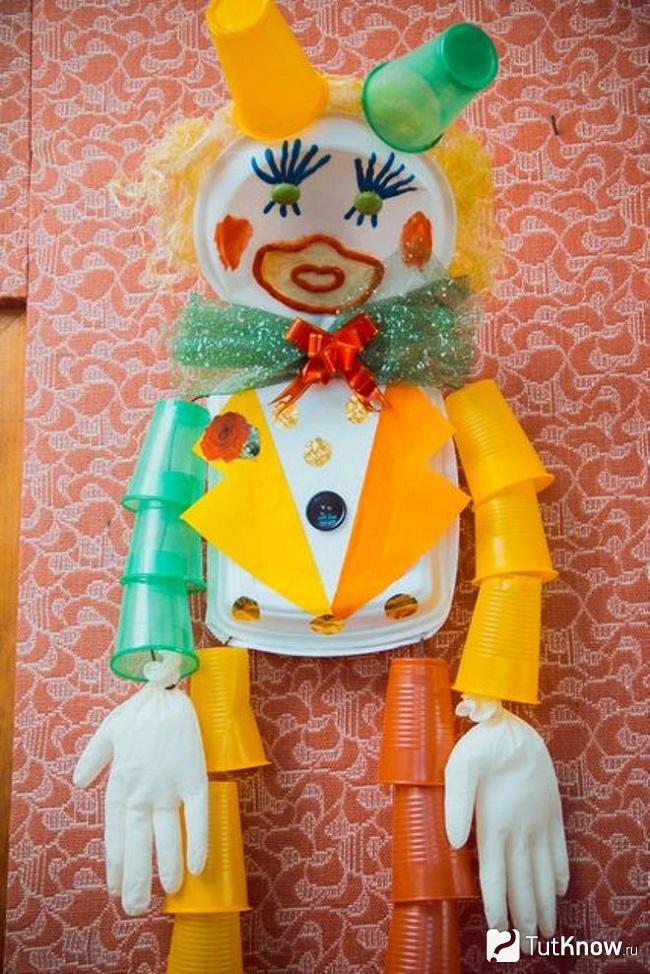
For it you will need:
- strong wire;
- disposable plates and glasses;
- plastic tray;
- rubber gloves;
- padding polyester;
- buttons;
- multi-colored threads;
- cardboard;
- plastic bottle;
- glue.
- Make a frame of a man out of wire. Thread cups onto each wire that became arms and legs, piercing their bottom.
- Glue 2 plates together, first placing plastic hair between them. Glue threads in the shape of a mouth, cheeks, eyelashes onto your face. And the pupils can be made from a plastic bottle.
- Two trays will become the back and front of the clown. Decorate his clothes with buttons, sparkles, cardboard, which will turn into a jacket collar.
- Stuff the gloves with padding polyester and attach them in place. This is how the theme of natural ecology came into play. After all, this garbage will not harm her if you make crafts like this for the dacha or for a competition.

To make the first toy, you need to take an empty plastic bottle of a similar shape, for example, from a “toilet duck”, rinse it well, and remove the label. Draw the windows and doors of this minibus with a felt-tip pen, cut them out with a knife and scissors.
To prevent your child from getting hurt on the sharp edges of the plastic, sand them first with coarse, then fine sandpaper.
Lids can be glued super glue by making wheels or using wire axles. Use an awl to make two punctures on one side and the same number on the other side of the bottom of the bottle. Insert one and a second wire into them, onto the ends of which you need to glue the lid, which will become the axes.
And to make a helicopter, you will need:
- 2 bottles of drinking yogurt;
- glue;
- 2 plastic bottle caps;
- cocktail straws;
- 2 nails;
- scissors.
Make runners from two straws, attach them to strips of plastic cut from the second bottle.
Using a hot thin nail with a wide head, make a hole in the lid and its attachment point, as well as at the ends of the straws. Match these parts to create the top propeller. In the tail part, make it out of straws.
If you need to quickly make a craft about the ecology of nature, use plastic bottles. Tell your child that those who throw them away in the forest harm nature. After all, such containers will rot only after 200 years! It’s better to make a craft out of it for a competition. It will take very little time and materials to make the next one, here they are:
- milk bottle;
- plasticine;
- 2 buttons;
- black and white cardboard;
- glue;
- pliers;
- wire in a white winding.
Have your child smear black play dough onto a bottle cap to create a nose for this rat. He will cut out ears from white cardboard, and a mustache for her from black cardboard. Using plasticine, attach the eyes to the muzzle.
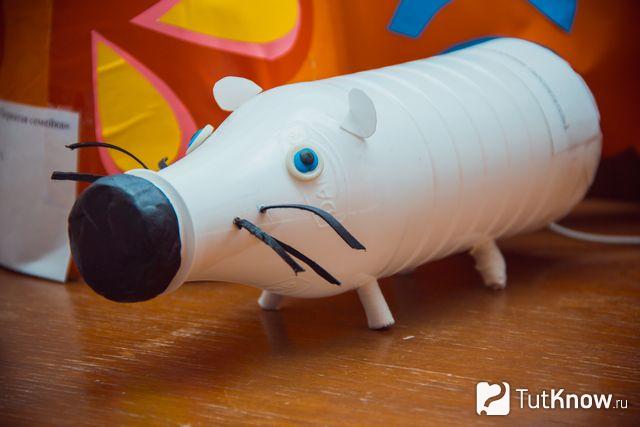
To make fun snowmen, show children how to draw on Actimel bottles with a marker to create the characters' facial features. You can teach your child to knit. Cast on 2 knitting needles and show him how to knit a rectangular fabric using garter stitch. Then you need to sew it on the wrong side. Afterwards, thread the needle and pass the thread into the upper part of the cap, tighten it.
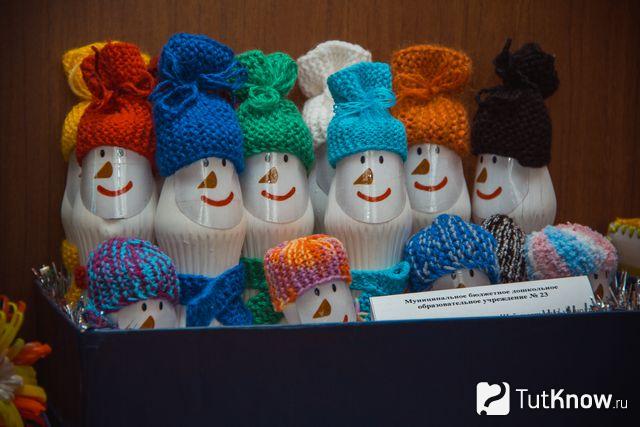
How to make a fan from forks was described in the corresponding article. Next to him, such an animal made from a plastic bottle will look wonderful.

You need to cut off the necks from the other two and glue them directly with the partings to the main container. The legs are done. The ears are cut out from the remains of the auxiliary bottle.
It's easy to create an adorable horse using two colorful bottles and a thread mop attachment.
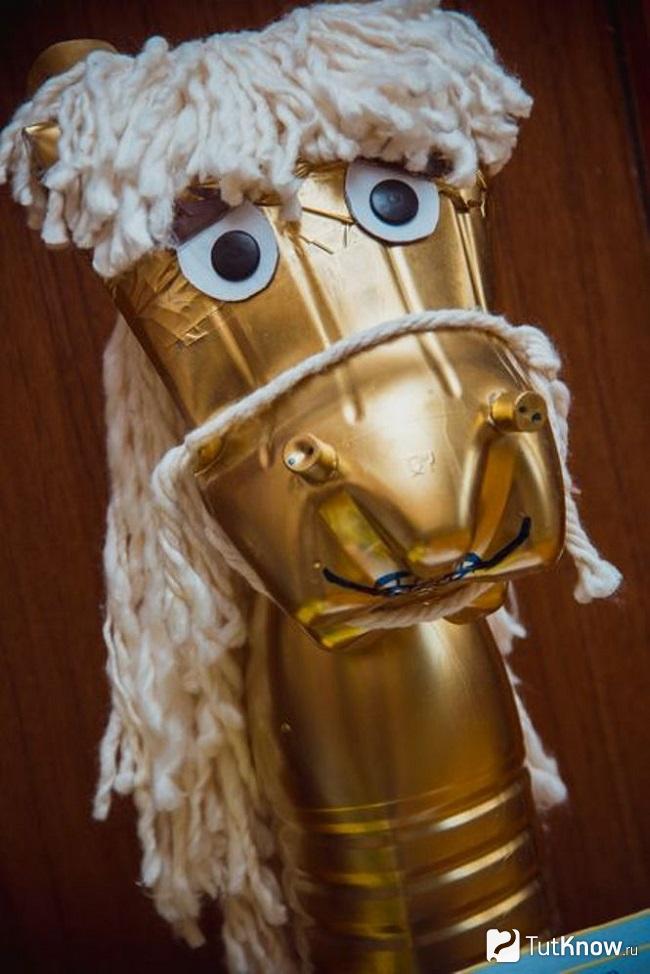
To make a cat you will need:
- 3 identical bottles;
- scissors;
- paints;
- brush;
- glue;
- piece of fur.
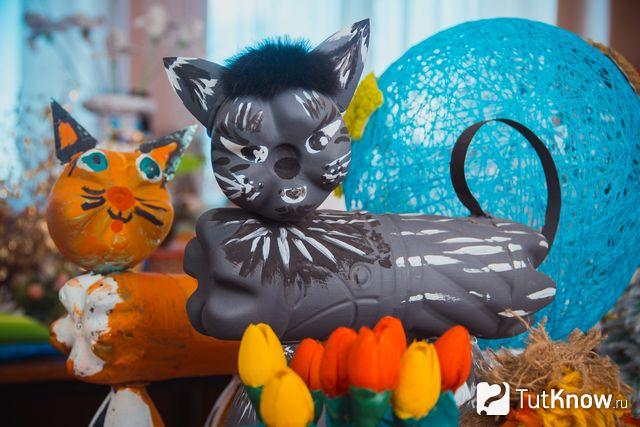
Flowers from a plastic bottle will also help turn waste into a decorative item or into an entry for a competition. Petals are cut out from this container. In order for them to bend like that, you need to hold the workpieces over the flame for a short time.
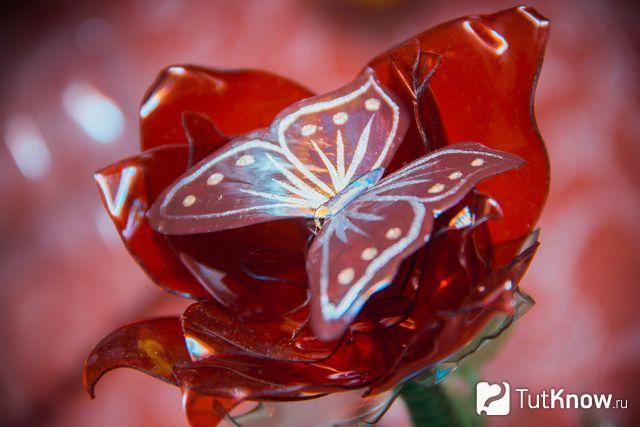
Crafts made from textiles and other materials
They will also show children how to make crafts from waste items, from leftover fabric and leather.
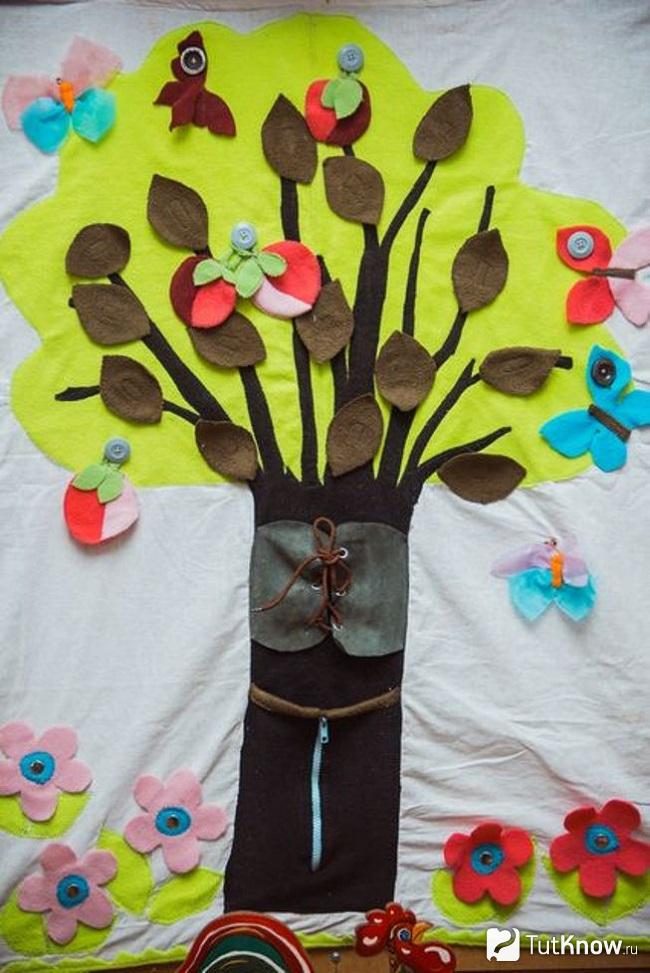
To make such a panel, take:
- scraps of fabric;
- pieces of suede;
- buttons;
- lacing;
- old zipper;
- unnecessary things;
- cardboard.
- A sheet of cardboard will become the basis of the canvas. If you want it to be voluminous, you can put a sheet of padding polyester between it and the fabric. If not, then immediately glue the rectangle of fabric onto the cardboard, or the child will do it.
- Let him cut out the trunk and branches of a tree from brown suede, and its crown from green fabric. If it is an apple tree, let him cut out fruits from scraps of the appropriate color. Sew loops to them, let him put them on the buttons sewn to the crown.
- To help your child develop hand motor skills, sew a zipper onto the trunk and let him unfasten and fasten it. Sew lacing here, which will also help development fine motor skills baby.
Like apples, cut out butterflies from thick fabric; they can also be attached to wood using loops and buttons.
A doll made from threads will be openwork and airy. To create it, you will need:
- 2 balloons;
- textile;
- PVA glue;
- needle;
- brush;
- flaps;
- buttons;
- a little wool or roving.
Let the child glue these 2 balls together and glue roving or wool on top of one, which will become the hair of the tumbler. Tie a scarf for her. The button will become her nose, a piece of red fabric will become her mouth, and blue and white will become her eyes. All that remains is to tie the scarf, the work is completed.
If mom has some cord left over from needlework, let her show her daughter or son how to sew on this thin braid by folding it to make a flower. You can first edge the fabric petals with this cord, and then stitch them onto the canvas.

Crafts to take care of nature can also be made from metal waste. See how unnecessary computer parts and an SD disk are turned into watches.

You can make an entire city out of garbage using wallpaper scraps, cardboard boxes, plastic bottles.

Even shavings from colored pencils can be put to good use by turning them into a chic princess dress. The girl will cut it out of colored paper.
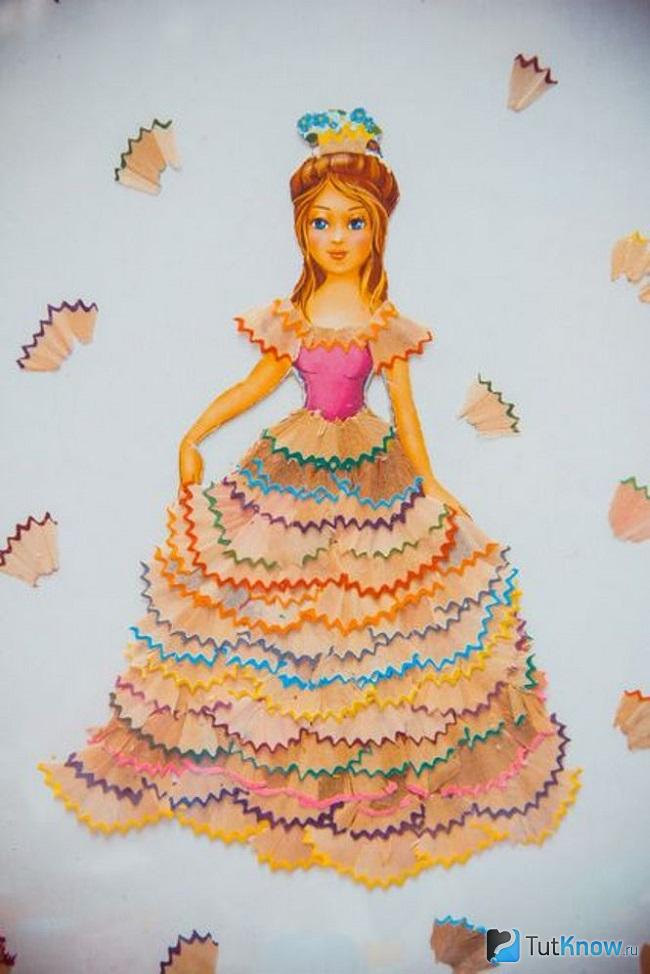
The following work shows how various waste materials can be used:
- candy wrappers;
- juice straws;
- plastic bottles for milk, sauces;
- buttons;
- corrugated paper;
- braid.
The stamens of the flower will be cut straws; they need to be glued around the button. The next flower can be created from candy wrapper. It is folded like an accordion, bent, and a button is glued or sewn into the center. The next flower is made from one piece of plastic.
All these plants are attached to the base and the panel is decorated with braid.
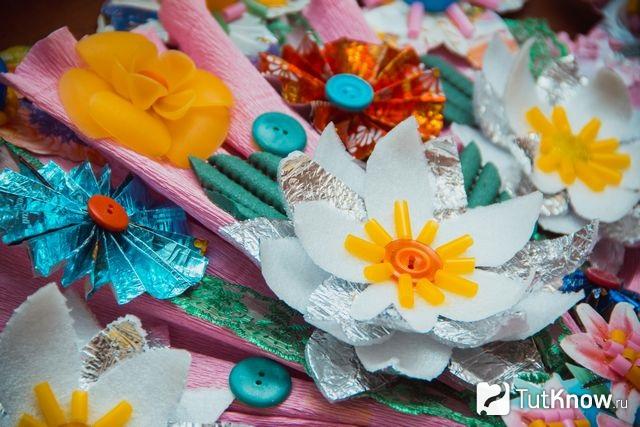
When creating such crafts with your children, tell them about the ecology of nature so that they know how such beautiful things can be made from garbage. The videos will help you get acquainted with other exciting ideas.
How to make a craft on the theme “Take care of nature”, see the following video:
Allow us to travel to magical world nature.
In this section you can learn how to make a lot of interesting things from natural materials.
The best time to collect material for natural crafts- summer and autumn.
Don’t pass by and be sure to take for work: leaves and flowers, you can use them to make beautiful crafts, good crafts are obtained from acorns with cups, cones, nuts, beans, beans, peas, fruits, vegetables, twigs are suitable for crafts, you can make natural crafts from sea and river shells, lionfish seeds and much more. Very beautiful crafts can also be made from simple pebbles. Wonderful crafts can be made from natural clay and even sand!
When making crafts, additional materials are also used: paper, cardboard, plasticine, wire, glue, etc.
We offer teachers assistance in certification. We place creative material in the official all-Russian online magazine "Doshkolnik.rf". The magazine is published on the 1st of every month and is in .pdf format. Publication documents are issued. It is sent to all authors of the issue and can be downloaded from the main page of the site. Has a media license and is registered with Roskomnadzor (EL No. FS77-55754). To publish in the journal and receive a Certificate of Publication you need to: send your material to: [email protected]
In order for your child to develop comprehensively, you must teach him to do things with meaning, and especially crafts on the theme take care of nature. Nature gives us a huge selection of materials for crafts; you just need to use your imagination a little. You can make bouquets and compositions from dried plants, make various animals, and depict the seasons.
Creating children's crafts on the theme of nature your child learns to see the unusual even in simple objects.
Natural materials are what nature so generously gives us, everything that can be found in a field, in a forest, in the steppe, on the seashore, on a river or even at home, taking seeds from an apple, watermelon, orange or pumpkin. And how many priceless finds can be found at every step in a park or forest during a walk: chestnuts, acorns, pine cones, nuts, feathers, fallen leaves and twigs, moss, dried flowers...
Explain to your child that if you need cones and leaves, it is better to collect those lying on the ground, and not to pick those that grow on the tree. If you need birch bark, you need to find a fallen tree. Step by step, gradually, the child begins to understand the role of man in preserving nature and life itself on earth.
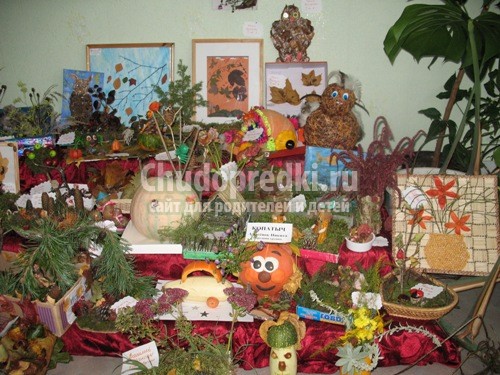
If you add plasticine and glue, cardboard and colored paper, small pieces of fabric, wire to this wealth, then you will have a wonderful set for making crafts from natural materials.
The most popular crafts on a spring theme are all kinds of flowers, which, as you know, are the best gift. It is not always possible to give fresh flowers, but you can always make them from various materials. Moreover, such flowers will not wither like living ones, and it will not be a pity to throw them out of the vase.
Flowers can be made from the most different materials: plasticine, clay, cardboard fabric, paper or even ordinary newspaper. You can make flower appliques from dry leaves or paper.
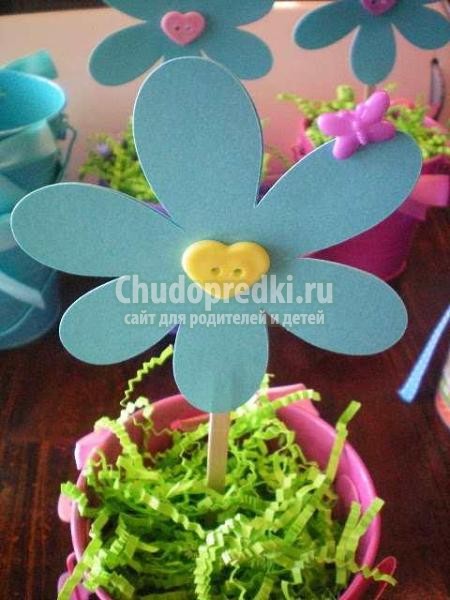
You can also make a beautiful spring hair accessory if you make a rose or other flower from the fabric.
You can glue the elements onto thick paper or cardboard and make beautiful picture, which will take a prominent place on the wall in the children's room, or make a homemade holiday card.
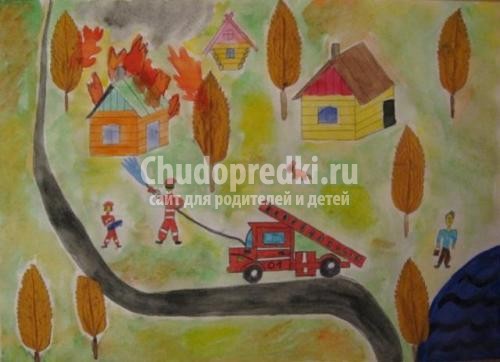
Crafts on the theme of nature conservation may also be in the form of drawings. For example, on the topic of extinguishing a fire or a drawing on the topic of caring for nature. When helping your child draw a picture, be sure to tell him why it is so important to light the fire after a picnic and clean up the trash after yourself.
From autumn leaves You can make a very beautiful tree with your child, which will delight you in winter, when everything outside the window is covered with snow.
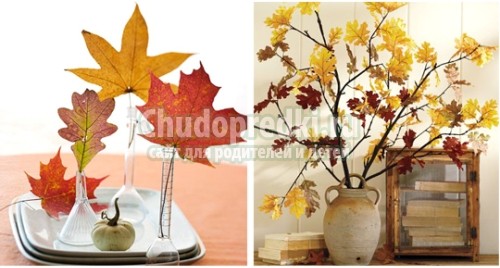
To make such a tree, you need to dry the leaves in advance, and then reattach them with transparent adhesive tape to a beautiful branch.
Interesting ones can be made from plasticine or salt dough. This activity is especially useful for children. preschool age, because, firstly, this is a material with which even small child, and, secondly, from it you can create both the most basic crafts and complex compositions, which will be interesting for older children.
Using plasticine you can introduce your child to the animal world. Of course, at first the parents will create more crafts from plasticine than the child. You can gradually involve your child in modeling, first by assigning him simple tasks. For example, roll up a tail for a plasticine cat.
Using plasticine and available natural materials, even with the smallest children you can create many interesting crafts. For example, cover a dry twig with green plasticine leaves or make a plasticine hedgehog and decorate it with fir needles.
You can also make a wonderful sheep from plasticine. Children will really like this work.
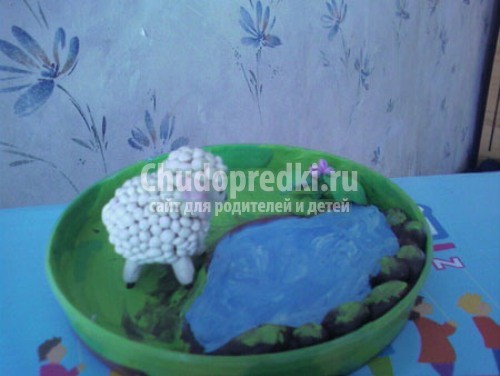
Take any jar or shallow mold and brown and black plasticine. Pinch off small pieces of plasticine, press them to the bottom of the container and smear them with your finger until the entire bottom is covered with “soil.” Then yellow plasticine and green flowers Coat the bottom and sides of the mold to create a “meadow”. For the sheep, you also need to make a reservoir, for example, a small lake. To do this, make a bank out of brown plasticine and attach it to the grass, and use blue plasticine to fill the bank with water. For beauty, the lake can be made from plasticine gray pebbles, and decorate the shore with flowers, grass or reeds. To make a sheep you will need plasticine white. Part of the block needs to be rolled into a ball, and then formed into an oval. This will be the blank for the body. After this, form an oval from a piece of plasticine half the size, give the face a shape and stick it to the body. You need to insert four matches into the body, onto which you first stick plasticine - these will be the legs of the sheep. In order to make a fur coat for a sheep, you need to roll out a lot of small balls and stick them on the body.
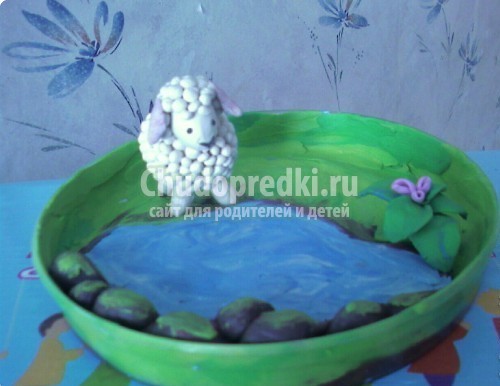
Next, mix pink and white plasticine and make ears and a mouth for your sheep, and use black plasticine for eyes and a nose. The very last detail is the ponytail. Roll a tiny thin sausage and stick it on the back of the body. Place the finished sheep anywhere on the composition - and your craft is ready! If desired, you can make several sheep of different sizes.
For children, an encounter with nature is an unforgettable new experience that sometimes lasts a lifetime. By inviting your child to make crafts from natural materials, you encourage the child to fantasize and use his imagination.
In general, there are a huge number of options for the manifestation of creative nature and the process of creation crafts on the theme of saving nature will be interesting for both children and adults, especially if you use complex materials in your work. The main thing is to explain to the child that man and nature are very closely interconnected. Nature creates all the necessary conditions for human life, which is why it is so important to live in harmony with it.
If you liked our site, express your "thank you"
by clicking on the buttons below.
It invites us to figure out what is good and what is bad we are doing in relation to nature, and how we can reuse something that served us once and is ready to turn into garbage. In the selection that the column leader made for us Maria Kostyuchenko , collected ecological (nature-saving) crafts and games that invite you to be more attentive to your “eco-footprint”.
On May 12, Russia and the countries of the former CIS celebrate Environmental Education Day. On this day, various environmental events are held in cities and towns, which are both educational and practical nature: exhibitions, conferences and children's creativity competitions on the topic of nature conservation are held, people participate in environmental activities - cleaning the banks of rivers and reservoirs, cleaning parks, landscaping areas. This holiday concerns everyone who takes part in promoting the idea of protecting nature.
The importance of environmental education is difficult to overestimate. It is the knowledge of what nature is, how it lives, how a person can influence nature, what the role of each of us is in all this that allows a person to realize what catastrophic phenomena harmful habits in relation to nature can lead to and understand how to avoid such consequences. The highest goal of environmental education is to form a so-called environmental culture.
So that caring for the environment not only brings benefits, but also works for general development, allowed me to get involved in the process with understanding, with interest, I want to offer you today a few interesting ideas, basically this is - various environmental games and crafts.
Let's take a pencil!
We will start by talking with the child about why and why we need to protect our planet, our nature, our forests and fields, rivers and lakes. And in order not to forget about this, you can do original notebook, in which you write what you can’t do, and what you can do, to keep our planet clean!
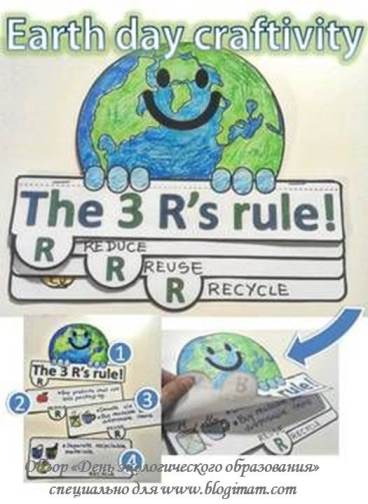
Poster dedicated to... garbage
Next, we’ll talk with the child about waste, about the garbage that people litter our planet with every day. Can be done huge poster on whatman paper, on which you and your child will post drawings or items that go into the trash every day - for example, plastic bags, bottles, food packaging or boxes, and much more. Next to each of the indicated items you can write your ideas for recycling or replacing them to litter less. For example, use reusable shopping bags instead of plastic bags.
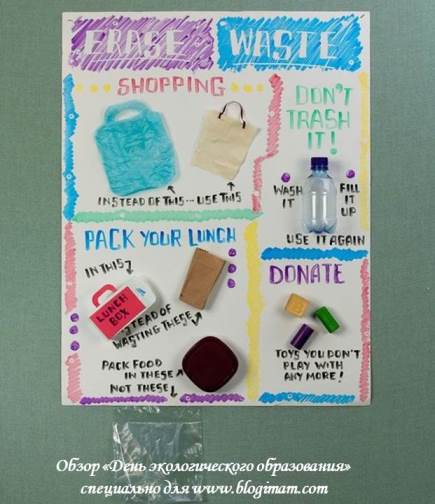
Creative crafts made from trash
The poster is ready! Now let's start acting eco-friendly!
You can start with creativity. Namely, from waste recycling.
One of the most common waste products is rolls from toilet paper that remain after its use. But you can come up with so many crafts and useful things from them!
- Firstly, rolls can be an excellent basis for creating a storage system for stationery and art supplies. You just need to decorate them beautifully and fasten them together - and here is a beautiful desktop stand ready.
- You can make unusual ones yourself from rolls toys and heroes of your games. With the help of such toys you can create your own fairy tales or act out existing ones.
- And if your baby loves music, then give him rain stick from a roll of foil or paper towel.

Crafts from caps and corks
- The second most popular waste (for me personally) are lids and corks. The most ordinary corks can be an excellent basis for creating unusual chess.
- Covers from baby puree Help your child explore emotions learn to compose human faces and animal faces, show your imagination!
- And you can make incredibly beautiful things out of bottle caps. animal and people appliques.

Crafts from Kinder Surprise capsules
Third in line are capsules from Kinder Surprises! Do your kids love these delicious chocolate eggs? What about playing with toys? Where do you send the capsules? Let's stop throwing them away and come up with a second life for them.
- If you have a lot of capsules of different colors and sizes accumulated at home, then I suggest you make set of matryoshka dolls!
- And if you only have small yellow capsules on hand, then come up with an image of some hero for each such capsule, for example - images minions, because the yellow capsules of Kinder Surprises seem to be created for minions!
- Is your baby still small? Then fill the capsules with cereal, peas, pasta, pebbles, secure the capsule with electrical tape (so that the child does not open it) and make noise! Let the baby learn to make sounds, look for pairs of sounds and just enjoy the process.

Crafts from disposable tableware
What else can be recycled? Disposable tableware! We buy it so as not to wash it and quickly throw it away. What if you wash it? You can make incredible things out of just one package of plastic spoons. adorable insects, develop the child’s horizons and take an unconventional look at the most ordinary things.
And if we stop throwing things away, we can build something like this: ferris wheel.
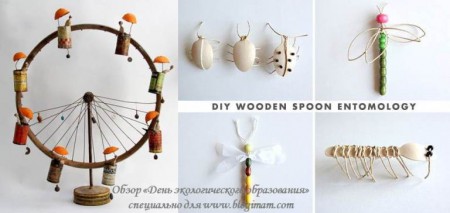
- More ideas
And if we do a little magic with the bottles, we can make handbags out of them for walking. What can you store in these bags? Pebbles, leaves, twigs. For what?
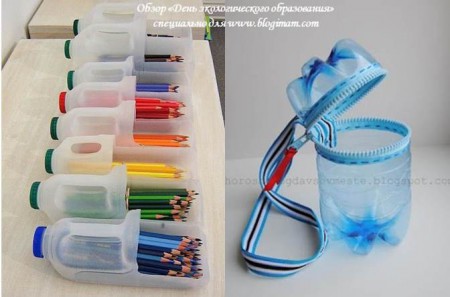
- More ideas
But why! To do natural land art, to create patterns from what nature itself gave us.
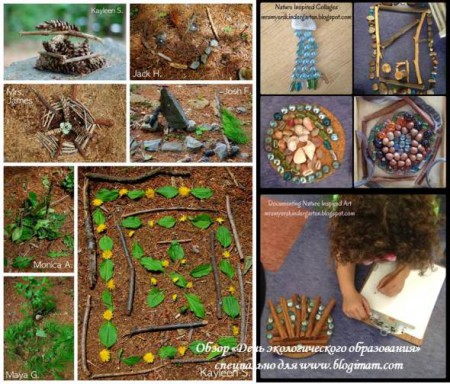
Ecological fairy tale game
How can we finish our lessons? Of course, a fairy tale. You can make finger toys depicting natural phenomena, people, garbage and stage a small performance.

Fiction or reality?
I would like to end today’s post with a reminder of one story.
Recently, Dasha and I read Kir Bulychev’s story “Vacation on Penelope.” This is one of the stories about Alisa Selezneva, with whom almost every parent is familiar. So this story is about an unusual planet on which there were no predators, no people, nothing bad. The astronauts found it and made it a planet for tourist trips, but at the same time they tried to treat it with care.
At some point, a man appeared who did not spare the planet, he caused her pain. He killed animals, blew up trees - and the planet changed. Predators appeared on it and earthquakes began. This would have continued until all the people died if Alice had not met a talking snake, which turned out to be the voice of the planet itself.
Planet Penelope was alive! She felt, she suffered when she was offended, and she tried to destroy the source of pain, which was people. So this story of Alice inspired me to think that maybe there is such a talking snake crawling across our Earth, or a lion walking, or a swallow flying, which are the voice of our planet, we just can’t hear them, we can’t stop and think about about what we are doing...
How quickly and powerfully we destroy the planet on which there is still life! And if Alisa Selezneva could board a spaceship and fly to another planet and live there, then you and I cannot. There are no such planets yet, or we don’t know about them yet, so all that remains for us is to take care of our dear Earth!!!

